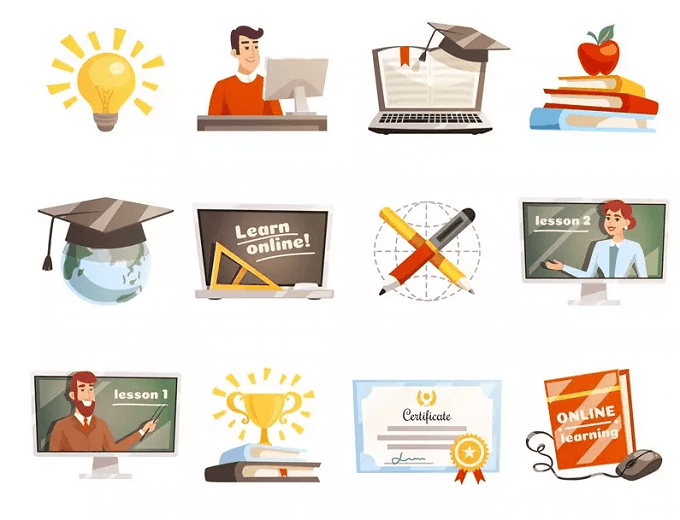At the bottom of their hearts, everybody is a child, fond of games. Games are not just used for relaxation and leisure time. Being used in different industries, they make the processes effective and engaging and make our lives fun.
The following article covers:
What is Gamification in Education?
Advantages of Gamification in the Classroom
What is Gamification in Education?
Gradually, the role of gamification is increasingly growing in education. The main reason is that it makes the hard stuff more fun, aiming to motivate students and engage them more with the subject matter.
Elearning gamification is the theory that students learn at the same time having fun. Having goals, targets, and achievements also prompts them to learn in the best possible way and is still perceived as fun.
These days there are many addictive features of video games that intrigue children and adults and get them hooked. And it's only natural that similar engagement results are experienced when these game-based elements are applied to learning materials.
Gamification in learning covers game-based elements such as point scoring, homework games, peer competition, teamwork, score tables, and gamification training.
These points drive engagement, helping students assimilate new information and test their knowledge. It can apply to school-based subjects but is also used widely in self-teaching apps and courses.
The most fantastic thing is that the effects of gamification do not stop along with the growing age; we are always fond of game-based learning.

Current technological devices spread throughout our daily lives, changing the way we live, shop, work, play, eat, meet people and socialize. Policy-makers start to seriously explore the potential benefits of using technology to streamline teacher workload.
We have also already known for some time that taking something many children love – games – and using some features to support learning has excellent benefits.
Advantages of Gamification in the Classroom
If you are unsure whether or not you want to gamify your classroom, check out the benefits of e-learning games. Why does gamification motivate the learner?
#1 Learning Process Becomes Fun and Interactive
Regardless of the preferences of your target audience or subject matter, educational classroom games have a positive influence on the process of creating exciting, educational, and entertaining content. This doesn't mean the work is turned into a game, but it helps to play on the psychology that drives human engagement.
All of us have experienced the drive to compete, improve, and outperform others, as well as ourselves. The rewards can be very satisfying and intensely motivating.
#2 Addiction to Learning
It is well known that games tend to arouse addiction. Children are significantly more likely to play games. If there is only one thing to define the most critical aspect of learning, it should be to add new skills, improving your learners' knowledge.
But how useful is that knowledge if it is not recognized? Another advantage of gamification in learning is the natural height it can give us and the impact that 'high' has on knowledge retention. When our brain wants to reward us, it releases dopamine into our bodies, so we feel good when we win a game or achieve something meaningful.

This becomes addictive to us. Gradually we do want more and more. Knowing different industries and topics, we are interested in is great.
#3 Increasing Engagement
When learning with the help of games, students tend to be more engaged in the learning material. They are more likely to study new topics and ideas to become more experienced and stand out in the competition. Accordingly, the game competition increases these students' desire to win the game and share the best of their knowledge.
Gamification in e-learning offers the opportunity for learners to engage with content in an informal but, at the same time, effective learning environment. If learners get excited about learning, they are more likely to hold on to the information.
The competition between groups or individual learners makes the process even more motivational. Everyone tends to be the first to provide the correct answer. Accordingly, learners work on improving their knowledge.
In the case of an online learning environment, the teacher may provide a leaders' board, and the students will be displayed on this board according to the results of completed courses or passed tests. Such an approach motivates the learners to do more and reach better results, or why not lead the board?
#4 Interactive Puzzles
Get creative, and use Im-a-puzzle to create interactive quizzes. Whenever students answer a question correctly, they unlock a jigsaw puzzle piece. Students have to open all the puzzle pieces and then put the puzzle together. It's a great way to get students engaged and learning all at the same time!
#5 Visibility of the Results
When learning through teacher-student games, learners see the numerical or any form of results through a progress bar. They know the active scores and shape a general idea about what is coming next. Accordingly, they prepare for the next step. Gamified learning makes progress visible via:
- earned points
- progress bars
- an overview or map of the learning content
- personalized goal-setting mechanisms

Thanks to such visibility, students quickly evaluate the upcoming steps and take stock of how far they've progressed in their learning – at any given time.
#6 The Fear of Being Failed Decreases
Failure is an integral part and a natural phenomenon in our daily life. As I say, "It isn't your choice to fail, but it is your choice to stand up." Failure is exceptionally usual in the learning process. You can fail to understand some topics or any aspect of the issue immediately, which is natural. Games in learning make it easier for you to deal with failure.
Gamification in education has a great benefit. It helps students to learn to fail and encourages them to reattempt learning tasks without embarrassment. Such an approach is spread along with academic progress and develops the determination, courage, and flexibility the students need.
#7 Gamification is Familiar
Learners used to play games. Organizing the learning process through gamification examples is helpful as the students do it in their comfort zone. So, they get out of their comfort zone but still feel comfortable.
Learners are usually familiar with the game rules as they have at least played something related. In this way, the chance of achieving progress increases. From the teachers' perspective, this makes gamification relatively aboveboard from a usual lesson management perspective.
Once they've got the hang of it, students can learn with games independently. It also empowers students.

With a learning activity that feels like second nature, they'll feel confident and in control of their progress.
#8 Rapid Feedback
Providing feedback is an integral part of the educational process. Doing it as quickly as possible is essential for teachers and students. Immediate or rapid feedback helps the teachers learn the students' current understanding and organize the different teaching processes accordingly.
Many technological tools help in this process of providing immediate feedback. One of them is automation in educational tests. When passing tests, learners get their results immediately. Such feedbacks motivate the learners to work on their weak points and improve their knowledge.
Gamification eLearning Examples
#1 Timed Quiz
Create a test and set a time for completion. Include interactive questions, add visual content, images, and videos, and arouse the participants' interest.
When the time is over, the test will be automatically submitted, no matter whether the learner managed to answer all the questions or not. The next step is the checking process which may be automatically completed by the system, saving you time wasted on mechanical work.
#2 Offer Badges to Motivate
These badges may be achieved while participating in specific lessons and webinars, completing online courses, or passing tests. Such an approach motivates the learners and encourages them to do more to earn more benefits in the form of microcredentials.

#3 Reward and Recognition
An avatar-based approach is efficient. The learners go through a series of gamified activities that map to the required qualities of a given reward category. The exercises stimulate and reinforce individuals' qualities to maintain to win.
The scores lead them to gain the reward. Such an approach also features leaderboards. Awards may also be related to the certificates that are generated automatically.
To Sum Up
Now that you know the importance of gamification in education, be creative and respond to student interests.
Choose a platform that will offer a satisfying experience for your learners. While students are collecting points, leveling up, and competing against each other, you may collect data, track progress, and tailor the rules, rewards, and quests to build a positive learning culture and environment while pushing student achievement.
Students become eager to participate in the activities they need to improve, and when they buy in, they make the course (or live lesson) a game worth playing.


![How to Start Online Coaching Business [Proven Strategies]](https://d35v9chtr4gec.cloudfront.net/uteach/articles/LXoil0HbCqKEO2lAdpzG-1693384984/start-online-coaching-business.jpg)
